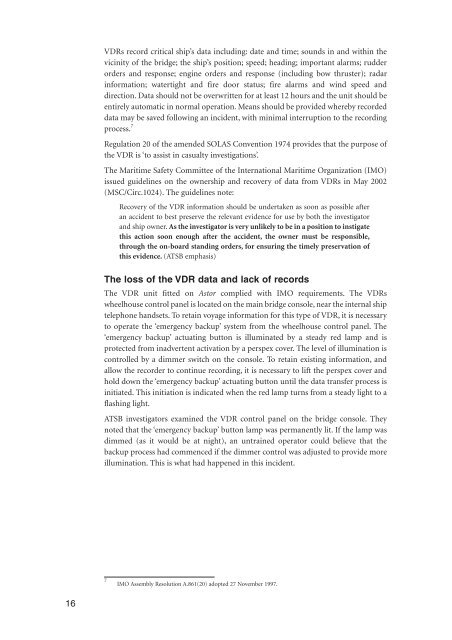MARINE SAFETY INVESTIGATION REPORT No. 200
MARINE SAFETY INVESTIGATION REPORT No. 200
MARINE SAFETY INVESTIGATION REPORT No. 200
Create successful ePaper yourself
Turn your PDF publications into a flip-book with our unique Google optimized e-Paper software.
16<br />
VDRs record critical ship’s data including: date and time; sounds in and within the<br />
vicinity of the bridge; the ship’s position; speed; heading; important alarms; rudder<br />
orders and response; engine orders and response (including bow thruster); radar<br />
information; watertight and fire door status; fire alarms and wind speed and<br />
direction. Data should not be overwritten for at least 12 hours and the unit should be<br />
entirely automatic in normal operation. Means should be provided whereby recorded<br />
data may be saved following an incident, with minimal interruption to the recording<br />
process. 7<br />
Regulation 20 of the amended SOLAS Convention 1974 provides that the purpose of<br />
the VDR is ‘to assist in casualty investigations’.<br />
The Maritime Safety Committee of the International Maritime Organization (IMO)<br />
issued guidelines on the ownership and recovery of data from VDRs in May <strong>200</strong>2<br />
(MSC/Circ.1024). The guidelines note:<br />
Recovery of the VDR information should be undertaken as soon as possible after<br />
an accident to best preserve the relevant evidence for use by both the investigator<br />
and ship owner. As the investigator is very unlikely to be in a position to instigate<br />
this action soon enough after the accident, the owner must be responsible,<br />
through the on-board standing orders, for ensuring the timely preservation of<br />
this evidence. (ATSB emphasis)<br />
The loss of the VDR data and lack of records<br />
The VDR unit fitted on Astor complied with IMO requirements. The VDRs<br />
wheelhouse control panel is located on the main bridge console, near the internal ship<br />
telephone handsets. To retain voyage information for this type of VDR, it is necessary<br />
to operate the ‘emergency backup’ system from the wheelhouse control panel. The<br />
‘emergency backup’ actuating button is illuminated by a steady red lamp and is<br />
protected from inadvertent activation by a perspex cover. The level of illumination is<br />
controlled by a dimmer switch on the console. To retain existing information, and<br />
allow the recorder to continue recording, it is necessary to lift the perspex cover and<br />
hold down the ‘emergency backup’ actuating button until the data transfer process is<br />
initiated. This initiation is indicated when the red lamp turns from a steady light to a<br />
flashing light.<br />
ATSB investigators examined the VDR control panel on the bridge console. They<br />
noted that the ‘emergency backup’ button lamp was permanently lit. If the lamp was<br />
dimmed (as it would be at night), an untrained operator could believe that the<br />
backup process had commenced if the dimmer control was adjusted to provide more<br />
illumination. This is what had happened in this incident.<br />
7<br />
IMO Assembly Resolution A.861(20) adopted 27 <strong>No</strong>vember 1997.
















